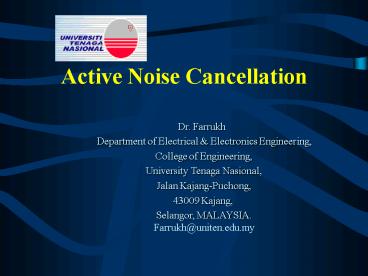Active Noise Cancellation - PowerPoint PPT Presentation
1 / 22
Title:
Active Noise Cancellation
Description:
Active Noise Cancellation. Dr. Farrukh. Department of Electrical & Electronics Engineering, College of Engineering, University Tenaga Nasional, ... – PowerPoint PPT presentation
Number of Views:1818
Avg rating:3.0/5.0
Title: Active Noise Cancellation
1
Active Noise Cancellation
- Dr. Farrukh
- Department of Electrical Electronics
Engineering, - College of Engineering,
- University Tenaga Nasional,
- Jalan Kajang-Puchong,
- 43009 Kajang,
- Selangor, MALAYSIA.
- Farrukh_at_uniten.edu.my
2
Description of paper
- Use of TMS320C5402 DSK-single TMS320C6701 EVM
dual channel channel Active Noise Cancellation in
duct system - Uses feedback feedforward topology -designed to
cancel narrowband periodic tones.
3
Problem Description!!!!
What is Noise ?????
- Unwanted sound that
- is often loud and irritating
- Industrial equipment
- Damaging to human from both
- a physical and psychological aspect
Active Noise Cancellation???
Reason
4
How does Active Noise Cancellation (ANC) works ?
- Identical and in phase
- Volumes increases
- Out of phase
- Volumes decreases
Active noise cancellation
- Basic principles by introducing a canceling
anti-noise signal that has the same amplitude but
the exact opposite phase and resulting a
reduction noise signal
5
Approaches of ANC
Hardware
- Feedforward Topology
- Reference noise and
- cancelled noise are used
- 2 inputs and 1 output
- Feedback Topology
- only cancelled noise
- are used one input and one output
- Use of TMS320C5402 DSK-single
- channel Active Noise Cancellation
- in duct system
6
Feedback Topology
Hardware
x(n)
e(n)
- to estimate primary
noise and use it as a reference
X(z) E(z) S(z)Y(z)
Duct system
y(n)
- Need to estimate the secondary path transfer
function
W(z)
S(z)
L MS
y(n)
x(n)
DSP System
7
Feedback Experimental Setup-ANC
Hardware
Noise loudspeaker
S(z)
x(n)
e(n)
Amplifier
Secondary Path
IN
OUT
y(n)
LMS Algorithm
DSP TMS320C5402 DSK
8
Feedforward Topology
x(n)
- Coherent input is captured, filtered and feed
into LMS
e(n)
d(n)
Primary function, P(z)
y(n)
Secondary Path,S(z)
Duct system
- Estimation of the secondary path transfer
function is obtained by identification process
y(n)
W(z)
Estimation of S(z), S(z)
LMS
e(n)
x(n)
DSP System
9
Feedforward Experimental Setup
Hardware
Canceling zone
Noise speaker
microphone
x(n)
S(z)
e(n)
Secondary Path
Input noise
y(n)
Canceling speaker
Amplifier
TMS320C6701 EVM DSP
10
Least Mean Square (LMS) Algorithm
Software
11
Secondary path S(z) duct modeling
Result of identification of the secondary path
12
Single channel cancellation results
Input Frequency 120Hz
13
(No Transcript)
14
Cancellation result on 7080100110120130Hz
15
Dual Channel cancellation Results
Input Frequency 80Hz
No cancellation With cancellation
16
Input Frequency 4070Hz
17
Cancellation result on 40 70 80Hz
18
Conclusions
- ANC was first time attempted in Malaysia and
obtained compatible results. - Integrated programming of DSP was achieved
without any external aid or training. - This work yields Masters thesis and research
papers accepted by local and international
conferences. - The expertise developed is now being shared with
other groups, projects and laboratory work in COE.
19
Future Scope
- Acoustic wave propagation in duct boundary is
investigated with PDE Finite Element method will
be the future direction - Boundary value conditions at the exhaust of duct
can be studied with FEM - Build dedicated DSP hardware for embedded
standalone ANC system - PCB for audio amplifiers and speakers are needed
for mobility of test rig
20
FINITE ELEMENT METHOD ANALYSIS OF DUCT SYSTEM
21
ACCOUSTIC ENERGY INSIDE THE DUCT
22
The end































